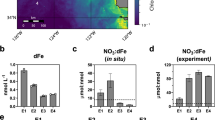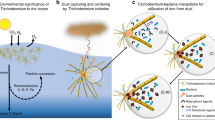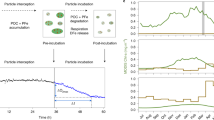Abstract
The role of iron in enhancing phytoplankton productivity in high nutrient, low chlorophyll oceanic regions was demonstrated first through iron-addition bioassay experiments1 and subsequently confirmed by large-scale iron fertilization experiments2. Iron supply has been hypothesized to limit nitrogen fixation and hence oceanic primary productivity on geological timescales3, providing an alternative to phosphorus as the ultimate limiting nutrient4. Oceanographic observations have been interpreted both to confirm and refute this hypothesis5,6, but direct experimental evidence is lacking7. We conducted experiments to test this hypothesis during the Meteor 55 cruise to the tropical North Atlantic. This region is rich in diazotrophs8 and strongly impacted by Saharan dust input9. Here we show that community primary productivity was nitrogen-limited, and that nitrogen fixation was co-limited by iron and phosphorus. Saharan dust addition stimulated nitrogen fixation, presumably by supplying both iron and phosphorus10,11. Our results support the hypothesis that aeolian mineral dust deposition promotes nitrogen fixation in the eastern tropical North Atlantic.
This is a preview of subscription content, access via your institution
Access options
Subscribe to this journal
Receive 51 print issues and online access
$199.00 per year
only $3.90 per issue
Buy this article
- Purchase on Springer Link
- Instant access to full article PDF
Prices may be subject to local taxes which are calculated during checkout

Similar content being viewed by others
References
Martin, J. H. & Fitzwater, S. E. Iron deficiency limits phytoplankton growth in the north-east Pacific subarctic. Nature 331, 341–343 (1988)
Boyd, P. et al. A mesoscale phytoplankton bloom in the polar Southern Ocean stimulated by iron fertilization. Nature 407, 695–702 (2000)
Falkowski, P. G. Evolution of the nitrogen cycle and its influence on the biological sequestration of CO2 in the ocean. Nature 387, 272–275 (1997)
Tyrrell, T. The relative influences of nitrogen and phosphorus on oceanic primary production. Nature 400, 525–531 (1999)
Sanudo-Wilhelmy, S. A. et al. Phosphorus limitation of nitrogen fixation by Trichodesmium in the central Atlantic Ocean. Nature 411, 66–69 (2001)
Wu, J., Sunda, W., Boyle, E. A. & Karl, D. M. Phosphate depletion in the Western North Atlantic Ocean. Science 289, 759–762 (2000)
Morel, F. M. M. & Price, N. M. The biogeochemical cycles of trace metals in the oceans. Science 300, 944–947 (2003)
Capone, D. G., Zehr, J. P., Paerl, H. W., Bergman, B. & Carpenter, E. J. Trichodesmium, a globally significant cyanobacterium. Science 276, 1221–1229 (1997)
Gao, Y., Kaufman, Y. J., Tanre, D., Kolber, D. & Falkowski, P. G. Seasonal distributions of aeolian iron fluxes to the global ocean. Geophys. Res. Lett. 28, 29–32 (2001)
Guieu, C., Loye-Pilot, M. D., Ridame, C. & Thomas, C. Chemical characterization of the Saharan dust end-member: Some biogeochemical implications for the western Mediterranean Sea. J. Geophys. Res. Atmos. 107, 4258 (2002)
Ridame, C. & Guieu, C. Saharan input of phosphate to the oligotrophic water of the open western Mediterranean Sea. Limnol. Oceanogr. 47, 856–869 (2002)
Redfield, A. C. The biological control of chemical factors in the environment. Am. Sci. 46, 205–221 (1958)
Graziano, L. M., Geider, R. J., Li, W. K. W. & Olaizola, M. Nitrogen limitation of North Atlantic phytoplankton: Analysis of physiological condition in nutrient enrichment experiments. Aquat. Microb. Ecol. 11, 53–64 (1996)
Berman-Frank, I., Cullen, J. T., Shaked, Y., Sherrell, R. M. & Falkowski, P. G. Iron availability, cellular iron quotas, and nitrogen fixation in Trichodesmium. Limnol. Oceanogr. 46, 1249–1260 (2001)
Gruber, N. & Sarmiento, J. L. Global patterns of marine nitrogen fixation and denitrification. Glob. Biogeochem. Cycles 11, 235–266 (1997)
Tyrrell, T. et al. Large-scale latitudinal distribution of Trichodesmium spp. in the Atlantic Ocean. J. Plankton Res. 25, 405–416 (2003)
Palinska, K. A. et al. The signal transducer P-II and bicarbonate acquisition in Prochlorococcus marinus PCC 9511, a marine cyanobacterium naturally deficient in nitrate and nitrite assimilation. Microbiology 148, 2405–2412 (2002)
Montoya, J. P., Voss, M., Kähler, P. & Capone, D. G. A simple, high-precision, high-sensitivity tracer assay for N2 fixation. Appl. Environ. Microbiol. 62, 986–993 (1996)
Lohrenz, S. et al. A comparison of in situ and simulated in situ methods for estimating primary production. J. Plankton Res. 14, 201–221 (1992)
Welschmeyer, N. Fluorometric analysis of chlorophyll a in the presence of chlorophyll b and pheopigments. Limnol. Oceanogr. 38, 1985–1992 (1994)
Zehr, J. P. et al. Unicellular cyanobacteria fix N2 in the subtropical North Pacific Ocean. Nature 412, 635–638 (2001)
Ammerman, J. W., Hood, R. R., Case, D. A. & Cotner, J. B. Phosphorus deficiency in the Atlantic: An emerging paradigm in oceanography. EOS Trans. Am. Geophys. Union 84, 165–170 (2003)
Coale, K. H., Fitzwater, S. E., Gordon, R. M., Johnson, K. S. & Barber, R. Control of community growth and export production by upwelled iron in the equatorial Pacific Ocean. Nature 379, 621–624 (1996)
Wu, J. F. et al. Dissolved inorganic phosphorus, dissolved iron, and Trichodesmium in the oligotrophic South China Sea. Global Biogeochem. Cycles 17, 1008 (2003)
Kustka, A., Sañudo-Wilhelmy, S., Carpenter, E. J., Capone, D. G. & Raven, J. A. A revised estimate of the iron use efficiency of nitrogen fixation, with special reference to the marine cyanobacterium Trichodesmium spp. (Cyanophyta). J. Phycol. 39, 12–25 (2003)
Rue, E. & Bruland, K. Complexation of Fe(III) by natural ligands in the central north Pacific as determined by a new competitive ligand equilibrium/absorptive cathodic voltammetry method. Mar. Chem. 50, 117–138 (1995)
Kustka, A. et al. Iron requirements for dinitrogen- and ammonium-supported growth in cultures of Trichodesmium (IMS 101): Comparison with nitrogen fixation rates and iron: carbon ratios of field populations. Limnol. Oceanogr. 48, 1869–1884 (2003)
Mahowald, N. et al. Dust sources and deposition during the last glacial maximum and current climate: A comparison of model results with paleodata from ice cores and marine sediments. J. Geophys. Res. Atmos. 104, 15895–15916 (1999)
Karl, D. et al. Dinitrogen fixation in the world's oceans. Biogeochemistry 57, 47–98 (2002)
Glibert, P. M. & Bronk, D. A. Release of dissolved organic nitrogen by marine diazotrophic cyanobacteria, Trichodesmium spp. Appl. Environ. Microbiol. 60, 3996–4000 (1994)
Acknowledgements
We would like to acknowledge the captain and crew of the F/S Meteor and the scientists aboard the Meteor 55 SOLAS cruise, especially D. Wallace, K. Lochte, H. Bange, P. Croot, M. Voss, F. Malien, R. Langlois and P. Fritsche. We thank D. Wallace for insightful comments on this manuscript. Additionally, we acknowledge W. Balzer for loaning the clean container used during M55. This work was supported by the Deutsche Forschungsgemeinschaft's Meteor Schwerpunktprogramm, a Natural Environment Research Council grant to R.J.G., and a Marie Curie Post Doctoral fellowship to C.R. Authors' contributions The first three authors made equal contributions to the success of the experiments. This manuscript is the product of an equal collaboration between the groups of J.L. at IfM-Geomar and R.J.G. at University of Essex.
Author information
Authors and Affiliations
Corresponding author
Ethics declarations
Competing interests
The authors declare that they have no competing financial interests.
Supplementary information
Supplementary Discussion
Contains results, Supplementary Table S1, Supplementary Figures S1 to S3 and references (DOC 108 kb)
Rights and permissions
About this article
Cite this article
Mills, M., Ridame, C., Davey, M. et al. Iron and phosphorus co-limit nitrogen fixation in the eastern tropical North Atlantic. Nature 429, 292–294 (2004). https://doi.org/10.1038/nature02550
Received:
Accepted:
Issue Date:
DOI: https://doi.org/10.1038/nature02550
This article is cited by
-
Hydrodynamic regimes modulate nitrogen fixation and the mode of diazotrophy in Lake Tanganyika
Nature Communications (2023)
-
Global analysis of ocean phytoplankton nutrient limitation reveals high prevalence of co-limitation
Nature Communications (2023)
-
The Ecological Differentiation of Particle-Attached and Free-Living Bacterial Communities in a Seasonal Flooding Lake—the Poyang Lake
Microbial Ecology (2023)
-
Nitrogen fixation rates in the Guinea Dome and the equatorial upwelling regions in the Atlantic Ocean
Biogeochemistry (2023)
-
Wet deposition of total nitrogen, dissolved organic carbon and heavy metals investigating role of long-range transport at two sites in Delhi
Journal of Atmospheric Chemistry (2023)
Comments
By submitting a comment you agree to abide by our Terms and Community Guidelines. If you find something abusive or that does not comply with our terms or guidelines please flag it as inappropriate.



